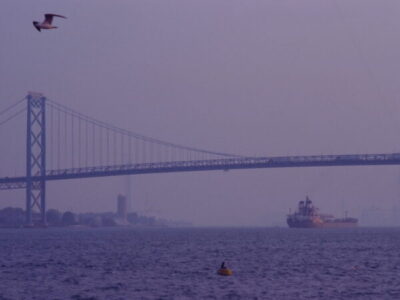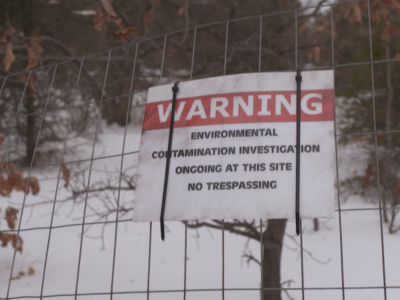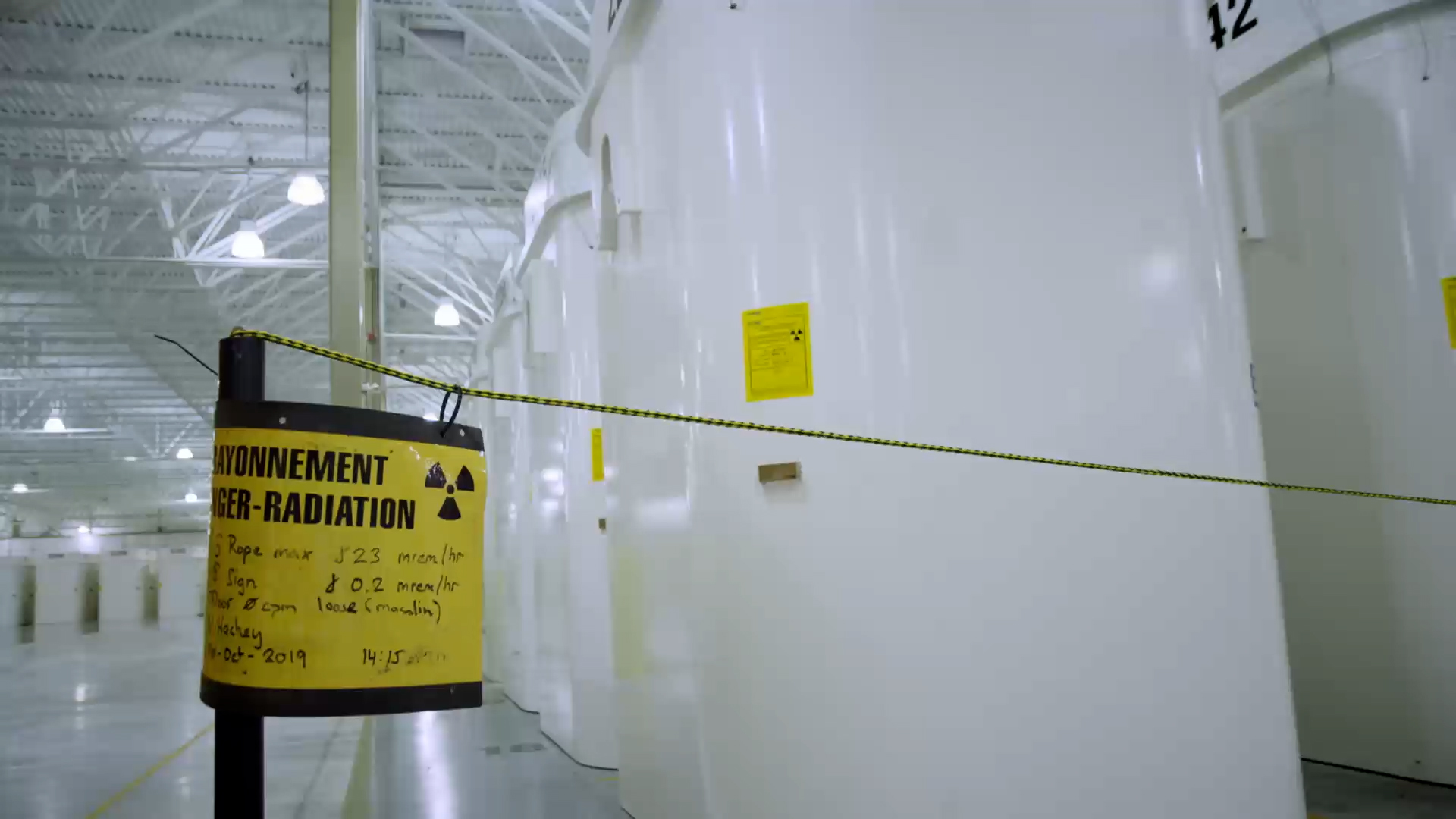
By Emma McIntosh, The Narwhal
This story first ran on The Narwhal, a non-profit news organization that publishes in-depth stories about Canada’s natural world.
The final resting place of Canada’s most radioactive nuclear waste could be a cave about as deep below the surface as the CN Tower is tall.
If it happens, the chamber and its network of tunnels will be drilled into bedrock in the Great Lakes basin. Pellets of spent nuclear fuel — baked into a ceramic form, loaded into bundles of metal tubes the size of fireplace logs, then placed into a metal container encased in clay made from volcanic ash — will be stacked in the underground chamber sealed with concrete 10 to 12 metres thick. Though the radioactive pellets will have spent several years cooling down in pools and concrete canisters, they will still emit so much energy that their presence will heat up the space where they sit for 30 to 60 years. The warmth will linger for anywhere from a few centuries to a few millennia.
But none of this will become reality unless the industry-backed Nuclear Waste Management Organization can find a willing host. Two Ontario towns are in the running: South Bruce, located about two hours’ drive northwest of Toronto near Lake Huron, and Ignace, roughly 200 kilometres north of Lake Superior, not far from the Manitoba border. The municipalities, along with 10 First Nations and two Métis councils, are awaiting the completion of dozens of studies as they mull whether the economic benefits of such a project outweigh the risks.
“We have to make sure that there isn’t an environmental risk for us, or it’s a relatively remote risk,” said Dave Rushton, a project manager for the Municipality of South Bruce.
“If anyone thinks they’re informed today, I kind of question it. We’re not fully informed because we haven’t got this information yet.”
The question of what to do with the waste cuts to the heart of a larger debate about the future of nuclear power in an era of climate crisis. Nuclear generation can produce electricity without carbon emissions: in Ontario, it played a pivotal role in replacing coal, which the province completely phased out by 2014. But no country in the world has solved the conundrum of how to permanently dispose of waste that will stay toxic for 400,000 years. And after decades of trying hard to figure it out, Canada doesn’t seem especially close to a solution.
“This is the legacy that we are leaving for our children, our grandchildren, great grandchildren, or great, great grandchildren,” said Bzauniibiikwe, whose English name is Joanne Keeshig. She’s Wolf Clan from Neyaashiinigmiing, also known as Chippewas of Nawash Unceded First Nation, which is located near the South Bruce proposal.
“Seven generations from now, this will not be resolved unless we start seriously taking a look at what can be done.”
Modelling suggests underground nuclear waste disposal is safe. But no country has tried it yet
The process of making nuclear power creates two main kinds of waste. One is high-level, the uranium-based spent fuel rods, which remain radioactive for a very long time. The other is low- to intermediate-level waste, like old pieces of reactors, used cleaning supplies and contaminated protective clothing from staff at nuclear plants.
In Canada, low- to intermediate-level waste is handled by the facilities that produce it: there are three nuclear generation stations and one research lab in Ontario, as well as a research site in Manitoba and a generation station each in Quebec and New Brunswick. Some of the material is incinerated, while the most radioactive objects are placed in steel-lined storage containers in the ground.
High-level waste, meanwhile, is the responsibility of the Nuclear Waste Management Organization, a non-profit established by Ontario Power Generation, New Brunswick Power Corporation, and Hydro-Québec. In the 60 or so years that Canada has produced nuclear power, it has never had a place to dispose of spent fuel. As of 2020, the country’s nuclear power utilities had produced about three million fire log-sized bundles of it — enough to fill eight hockey arenas from the ice to the top of the boards — and that number grows by about 90,000 each year. In the absence of a place to leave it permanently, producers are currently keeping high-level waste in temporary storage near the reactors. By 2100, when the federal government says it expects all of the country’s existing nuclear plants to be decommissioned, industry projects it will be holding onto nearly 5.6 million bundles.
Accumulating nuclear waste has raised red flags for a long time. In 1978, the Ontario government commissioned a report titled “A Race Against Time,” which concluded the waste was proving trickier to handle than experts initially thought and suggested a potential moratorium on new nuclear plants if the industry didn’t progress within eight years.
Another report from the United Kingdom the same year came to a similar but stronger conclusion, said Gordon Edwards, a mathematician who has long critiqued the nuclear industry as the president of the not-for-profit Canadian Coalition for Nuclear Responsibility.
“One of their main conclusions was that we are agreed that it would be irresponsible and morally wrong to commit future generations to a technology that produces such dangerous material, unless there is at least one proven safe method of dealing with it,” Edwards said.
“The problem with radioactivity is you can’t shut it off … You have to somehow keep it out of the environment.”
Federal and provincial governments never issued a moratorium: construction on the Darlington plant in Bowmanville, Ont., which had been approved in 1977, began in the ‘80s. The Bruce and Pickering plants, meanwhile, continued to get new reactors.
These days, the federal government is pushing to advance new nuclear technology, called small modular nuclear reactors (commonly known as SMRs), which some argue could be a climate mitigation tool. The technology is less efficient than larger reactors and produces more waste. Two of these new reactors might be built in the near future — the Canadian Nuclear Safety Commission, which oversees the industry, is considering an application for one at the Chalk River Laboratories research site in Deep River, Ont., and Ontario Power Generation has announced its intent to build another at Darlington.
In 2002, Parliament did pass legislation requiring the industry to band together and deal with its waste and later that year, the Nuclear Waste Management Organization was formed. Twenty years on, it still hasn’t figured out what to do with high-level radioactive waste. Keeping it above ground, as is done now, leaves it vulnerable to natural disasters, or human ones like terrorism and war.
“It’s a question of ethics,” said Brian Ikeda, an associate professor at Ontario Tech University who studies the management of radioactive waste and has a contract to do upcoming work for the Nuclear Waste Management Organization.
“Do you want to leave this stuff — which you don’t like and you think is really dangerous — and have your grandchildren figure out what to do with it? Because that’s what’s actually going to happen … we could be putting those people at huge risk by having this material out.”
As such, a consensus has emerged among global experts that the best way forward is to dispose of spent fuel far underground, a concept called a deep geological repository. But putting nuclear waste underground isn’t simple.
The waste — which in worst-case scenarios could poison groundwater or soil — must be packaged securely enough to withstand a future ice age, which could bring massive glaciers three kilometres thick, heavy enough to affect underground geology. It must be placed in rock that is stable and won’t shift for 400,000 years, the length of time the Nuclear Waste Management Organization believes the waste would remain radioactive enough to be harmful if leaked. It must be climate change proof.
It must also account for the many unknowns of future generations, who might not know how to actively maintain the storage site, but on the other hand will hopefully be able to monitor it. It must be buried so deep that, if our languages disappear or the information about what’s sealed within is somehow lost, our descendants would be unlikely to disturb the buried chamber and expose themselves to the unimaginable risk inside.



These proposed warnings, meant to deter future humans from disturbing nuclear waste disposal sites, were produced for the U.S. Department of Energy in the 1990s. Experts also considered ideas like pictograms and imposing physical structures. Illustrations: U.S. Department of Energy
Another challenge is the simple fact of entropy: everything breaks down over time. No matter what type of container holds the nuclear waste, its material will corrode over the course of many thousands of years, Ikeda said. The trick is to buy as much time as possible.
The containers are designed so that, ideally, their inevitable failure is unfathomably far into the future, when the nuclear fuel is far less dangerous. Because at that point, fuel will be vulnerable to leaching out into groundwater flowing through connected pores in the rock. This is where the depth and the rock itself provide another backstop — luckily, aquifers that reach so deep beneath Earth’s surface move torturously slow, sometimes taking 1,000 years to advance just one metre. And all the while, the radioactive isotopes in the spent fuel will continue to decay.
“For even the long-lived isotopes, it’s going to take them a very long time to get to the surface,” Ikeda said. “The modeling is to show that when they do get to the environment, that there isn’t very much there. It’s safe.”
Critics say the whole idea is reckless, and wonder how we can really know anything about what the world will look like in 400,000 years. The ice sheet that formed the Great Lakes only melted 20,000 years ago. In October, Michigan Gov. Gretchen Whitmer raised concerns about the prospect, saying nuclear waste disposal so close to the Great Lakes would be too risky.
And humans are famously good at wrecking things quickly. “The pyramids of Egypt are only (about) 5,000 years old, and look at them, they’re not in great shape,” Edwards, of the Canadian Coalition for Nuclear Responsibility, said. “It’s questionable.”
In an email, Nuclear Waste Management Organization spokesperson Jonathan Zettel said the repository would be built in a section of rock that has been very, very far from the surface for hundreds of millions of years. “It is precisely this stable environment we need for the long-term management of used nuclear fuel,” he wrote. In an email sent after this story was published, Zettel added that the spent fuel containers would also be coated in copper metal that “simply doesn’t corrode,” and that even in extreme and unlikely scenarios it would be expected to degrade by about 1.25 millimetres over a million years. He also said the organization’s research shows the rock at both proposed sites is dense and difficult for water to penetrate, with no aquifers at the depth of the proposed repository.
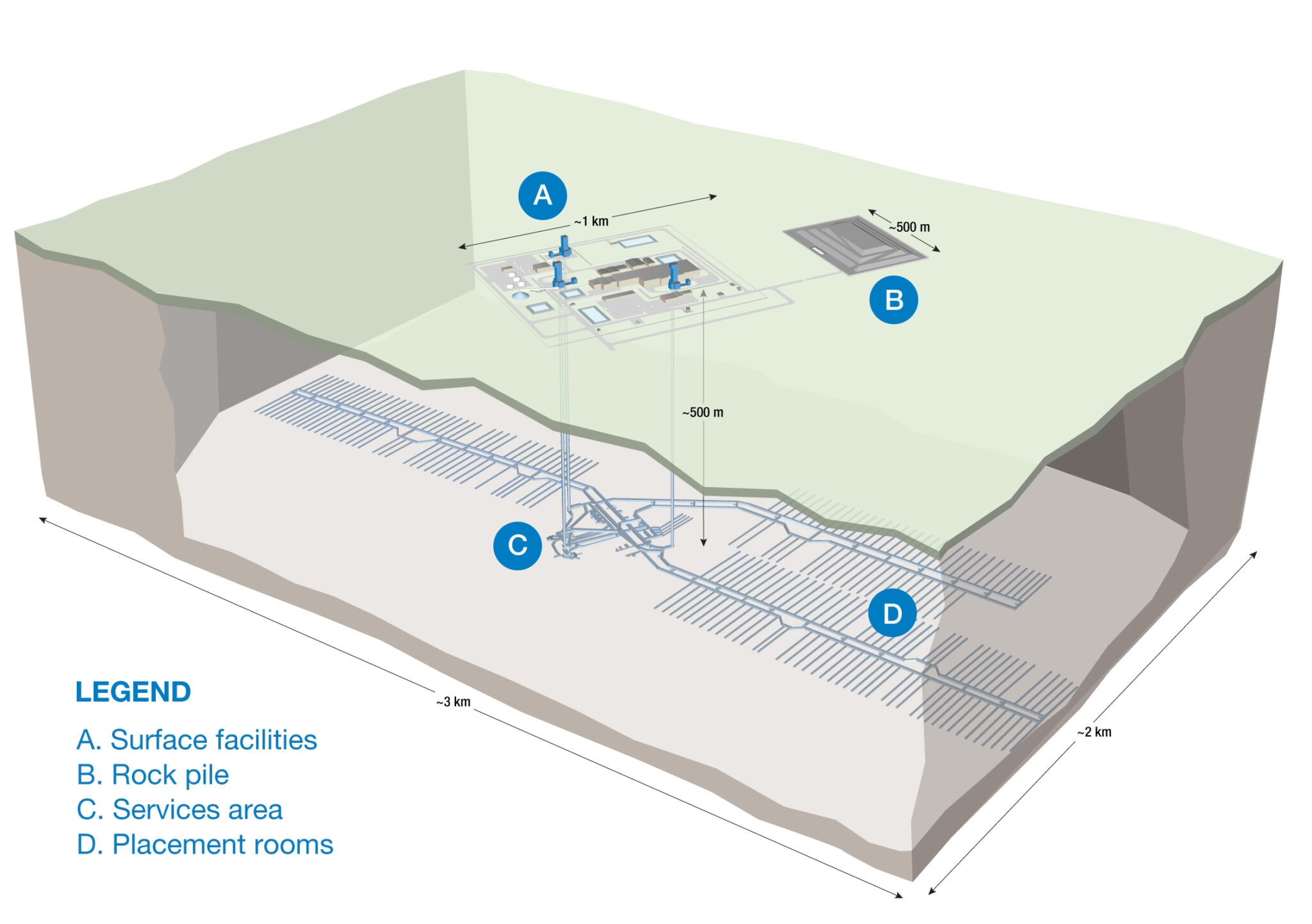
A three-dimensional model of the Nuclear Waste Management Organization’s plans for disposing of spent fuel underground. Illustration: Nuclear Waste Management Organization
Zettel said the organization is testing to see what would happen in a wide variety of scenarios, including what would happen if the containers fail after 10,000 or 60,000 years. It also said the group’s plan would bring the spent fuel further away from the Great Lakes — right now, it’s being stored at reactors closer to the lakes, while a deep geologic repository would be dug further inland.
“The entire purpose of Canada’s deep geological repository — the reason we are investing time, effort and money — is to protect people and the environment including precious water resources like the Great Lakes for generations and generations to come,” Zettel said in an email.
“There are strict requirements to ensure that radiation does not move from the underground repository and that people and the environment are protected.
Canada doesn’t have a deep geologic repository yet, but countries like Sweden and Finland have used them for low- and intermediate-level waste for decades, and the United States uses one in New Mexico for waste from its nuclear defence program. But the concept has never been tried before for high-level waste. Finland started excavating the first tunnel of its planned high-level deep geological repository facility last year. It may well be the first of its kind in the world.
Ikeda acknowledged the many unknowns, but still stands behind the idea.
“The first thing you have to recognize is that there are no guarantees, you can’t be 100 per cent sure of anything,” he said. “With that, the only surety that we have that this is safe is that we have studied it. We have done a lot of modelling.”

Many First Nations are located near Ignace, Ont., which is one proposed site for the Nuclear Waste Management Organization’s deep geologic repository to dispose of high-level nuclear waste. Map: Jeannie Phan / The Narwhal
Finding a nuclear waste disposal site in Ontario will require First Nations consent and buy-in from local towns
The Nuclear Waste Management Organization started its process of selecting a site for the $25-billion project in 2010. The group offers funding to all communities being considered, saying it’s a no-strings-attached pot of money for infrastructure projects meant to help communities prepare to be a good host, and to cover the costs of participating in the process, like hiring experts and taking part in studies. In South Bruce, for example, it’s been used for things like doctor recruitment and playgrounds. The communities keep the funding even if they’re eliminated from consideration, or decide to withdraw.
The organization originally scouted 22 municipalities, and has whittled the options down to two. In far northwestern Ontario, just west of Ignace, the organization is proposing to place the repository on Crown land. It finished a round of borehole testing in November. The site is on the traditional territory of Wabigoon Lake Ojibway Nation, and about 20 kilometres southeast of the reserve — the community hasn’t made a final decision on whether it supports the project, and Chief Clayton Wetelainen said in October that the nation isn’t ready to formally partner with the Nuclear Waste Management Organization. “We’re still in a learning phase, and we still hold the authorization to stop the project,” he told local news site TBnewswatch.com.
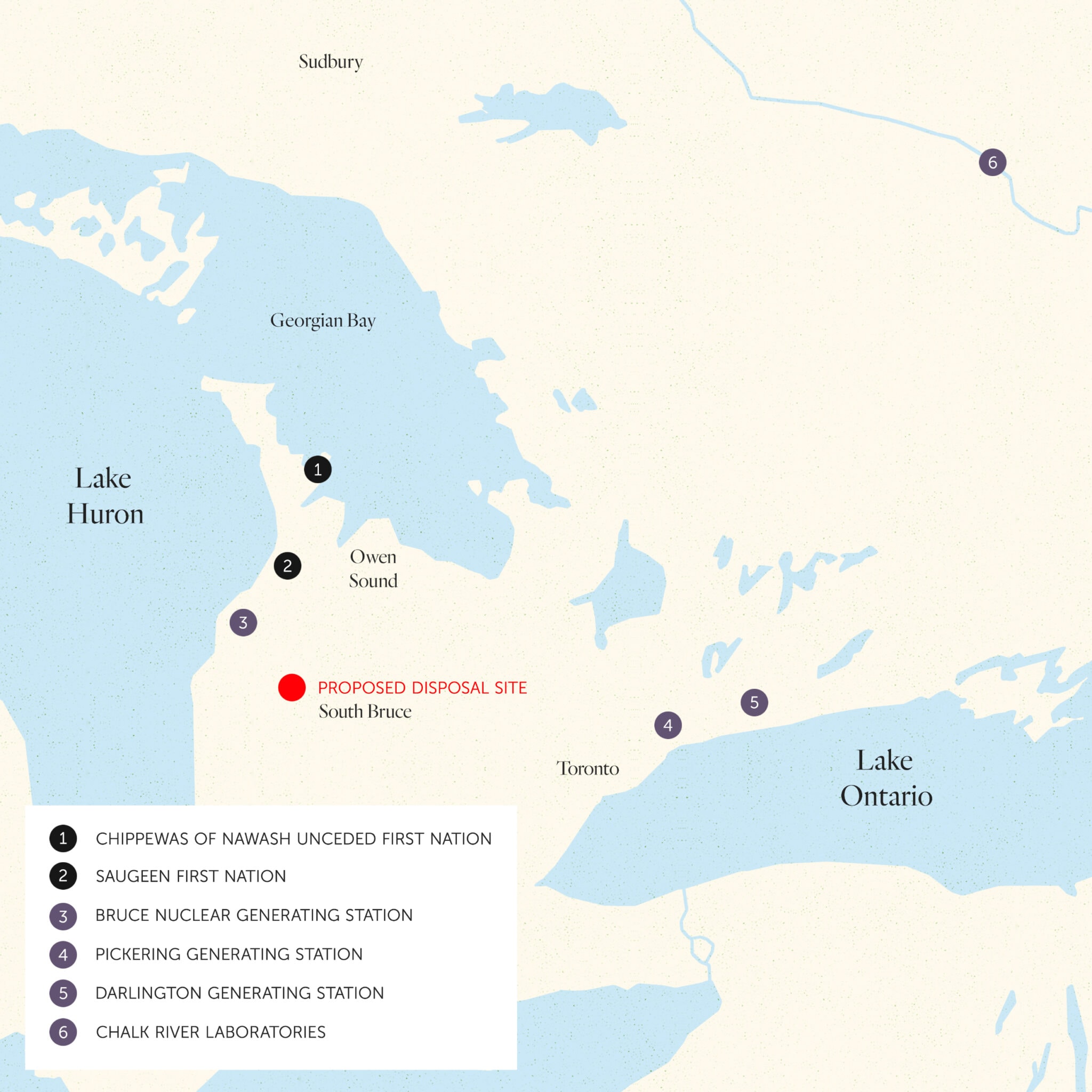
Three nuclear generating stations and a research centre are currently sites for temporary storage of nuclear waste in Ontario. The municipality of South Bruce, Ont. is one potential location of a permanent disposal site, a deep geologic repository built by the Nuclear Waste Management Organization. Map: Jeannie Phan / The Narwhal
“After 10 years, you would think that we’d be in the position to make a decision on whether or not this is a good thing to be doing,” said Noll, who recently moved away from South Bruce to be closer to family.
South Bruce, like many agricultural communities, has seen its population dwindle in recent years, and proponents argue that the economic benefits of hosting the deep geologic repository mean it’s worth pursuing. Hosting the disposal site could bring hundreds of stable jobs, something Rushton said he hopes would revitalize the municipality that he works for.
“We want to ensure that we have health care within the community, we want to ensure that there’s good services for the folks in our community. And with our population base, we can’t offer that,” he said. In Finland, a similar argument won over the municipality of Eurajoki, which is already near a nuclear power plant and agreed to host the country’s disposal site after a relatively smooth consultation process.
Farther north, along the Trans-Canada Highway between Thunder Bay and Kenora, residents in Ignace are weighing similar questions. Its mining heyday over, the township is also looking for stability.
“This project is 150 years, give or take,” Mayor Penny Lucas said. “That’s three generations of people that would enjoy economic benefits … It’s not going to be like the mining, a boom and bust (where) all of a sudden, this community is full of money and people and whatever and then all of a sudden they’re gonna be gone again.”
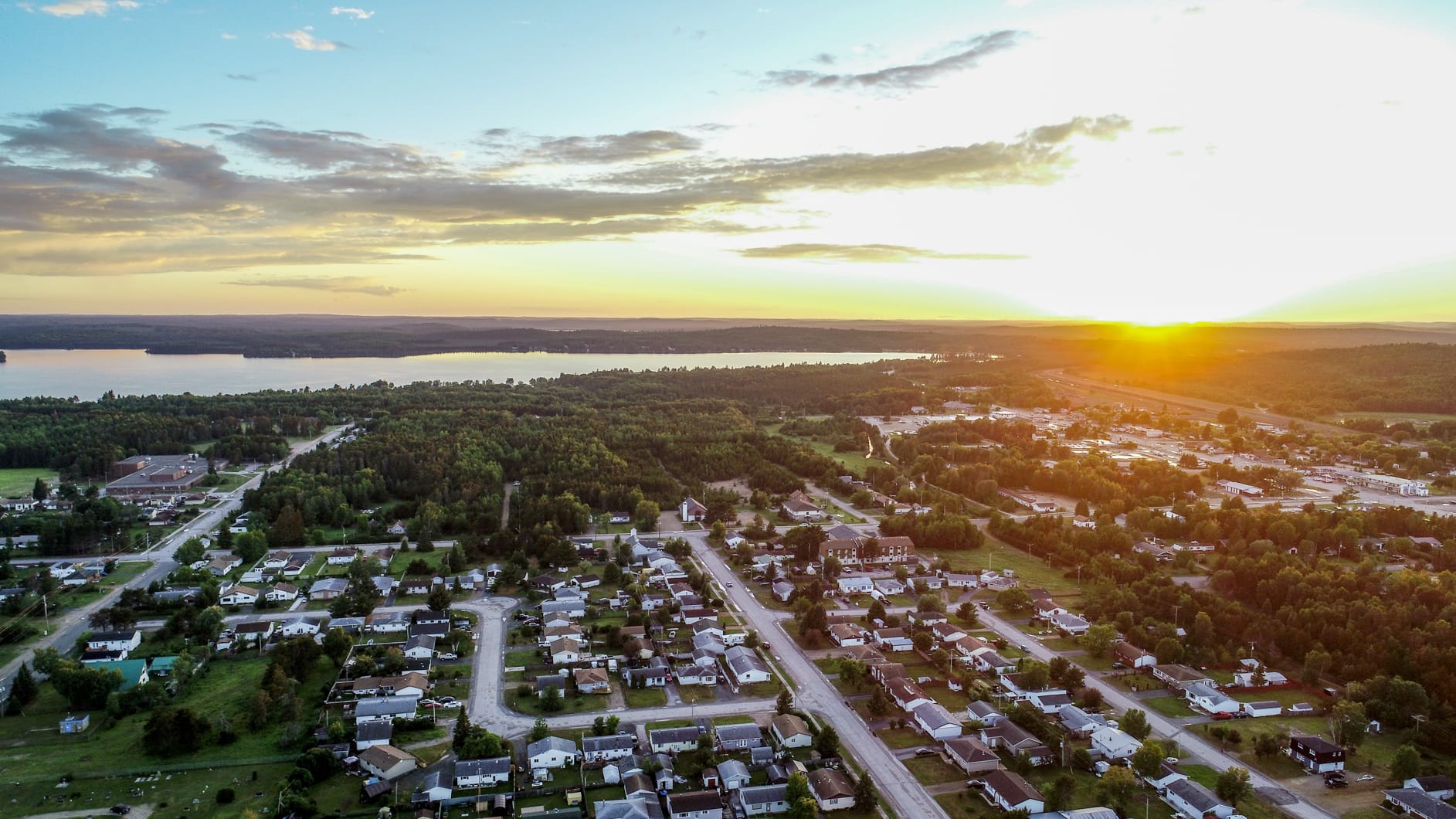
An aerial photo of Ignace, Ont., which may be the host for a proposed nuclear waste disposal site. Photo: Nuclear Waste Management Organization
Local critics question, however, whether Ignace can speak for all of the communities in the area. The proposed disposal site would also impact the city of Dryden, Wabigoon Lake Ojibway Nation and nine other First Nations, including Lac Des Mille Lacs First Nation, Ojibway Nation of Saugeen (a separate entity from Saugeen Ojibway Nation), Lac Seul First Nation, Seine River First Nation, Nigigoonsiminikaaning First Nation, Eagle Lake First Nation and Naotkamegwanning First Nation. Representatives for the nations didn’t respond to requests for interviews. People in the communities have raised concerns independently, however, and in 2020 a woman from Ojibway Nation of Saugeen walked hundreds of kilometres to raise awareness of the proposal.
Others in Northwestern Ontario also have concerns. Chief Duncan Michano of Biigtigong Nishnaabeg, an Ojibway First Nation on Lake Superior between Sault Ste. Marie and Thunder Bay, said he’s concerned about how nuclear waste disposal could impact his region’s many lakes and rivers. Biigtigong Nishnaabeg is also near the Trans Canada Highway, along which nuclear waste would be taken north if Ignace is chosen to host the repository.
“They’ve got so much (nuclear waste) now they don’t even know what to do with it. What’s gonna happen 100 years down the road, 200 years down the road, 1,000 years down the road?” Michano said. “We’re leaving ticking time bombs for people in the future … The transportation of that stuff by our territory, it’s basically the legacy that we leave for future generations.”
Michano would rather see Canada abandon nuclear power altogether. In 2018, he authored resolutions passed by the Chiefs of Ontario and Assembly of First Nations calling on governments to stop their push for new small modular reactors, pointing specifically to the issue of dealing with nuclear waste. The Anishinabek Nation made a similar statement in 2021: “We need to protect our water bodies from anything that can harm them, and that includes toxic pollution such as nuclear waste,” Grand Chief Glen Hare said.
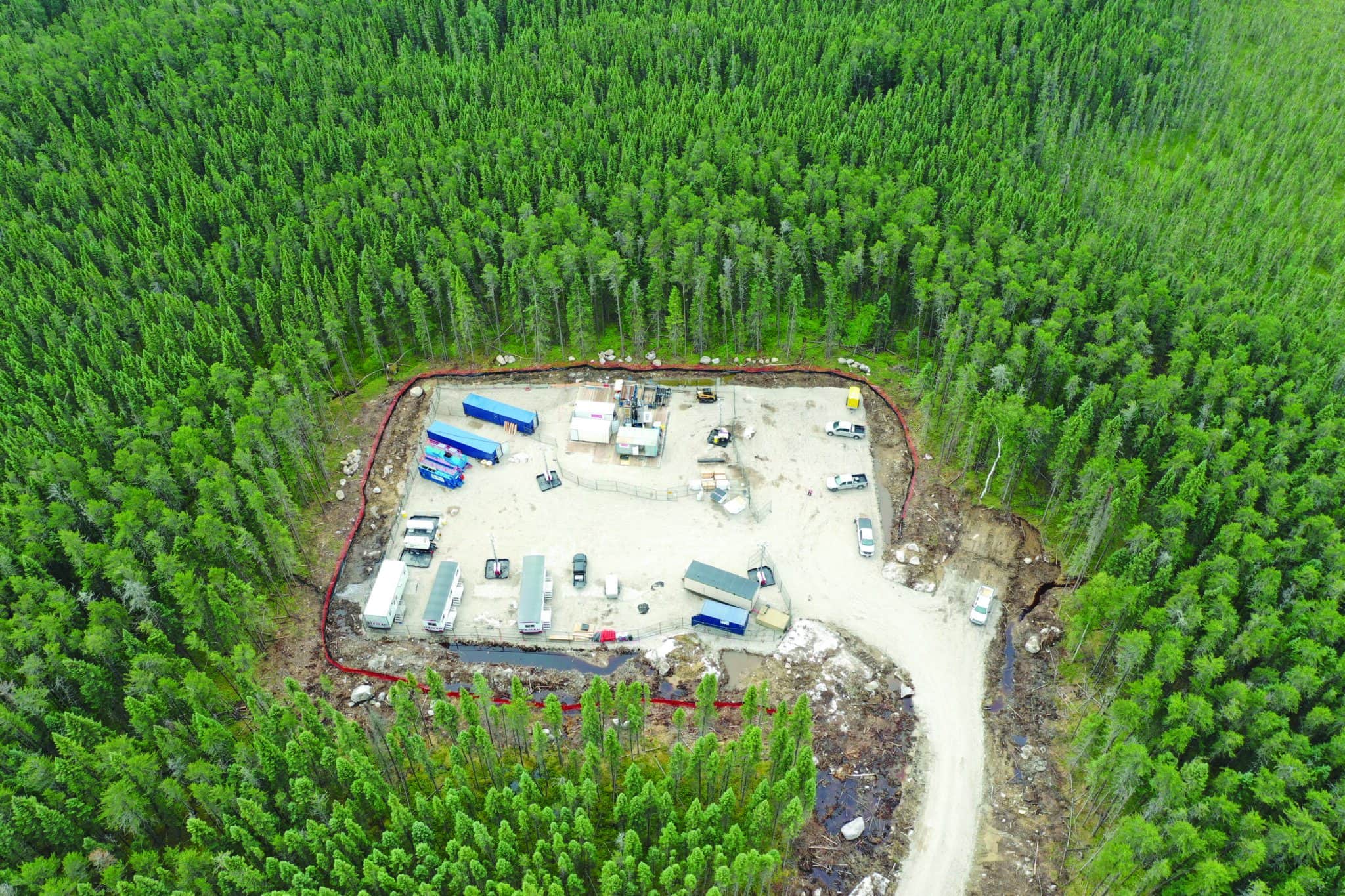
A 2019 aerial photo of the site near Ignace, Ont., where the Nuclear Waste Management Organization is doing borehole testing for a proposed deep geologic repository. Photo: Nuclear Waste Management Organization
The Nuclear Waste Management Organization has said it won’t select a site without the consent of communities like Saugeen Ojibway Nation and Wabigoon Lake Ojibway Nation, and is taking into account the opinion of communities nearby and along transportation routes.
Ignace’s municipal council is expected to make a decision about whether it’s willing to host the repository in 2023. South Bruce has resolved to make its decision through a referendum: the current council has agreed that the referendum will only be binding if at least half of the eligible population votes, and the project will only proceed if approved by over 50 per cent of those who turn out. Even then, any eventual repository would be subject to a federal impact assessment, which could take many years and involve rounds of public consultation.
If no community eventually agrees to host, it’s not clear what the Nuclear Waste Management Organization’s backup plan will be.
“Today, we feel confident we are on track to identify a safe site, with informed and willing hosts,” Zettel said in an email.
“If informed and willing hosts are not identified, we will continue to work with Canadians and Indigenous peoples to decide the best way forward for its safe, long-term management. In the meantime, the used nuclear fuel will continue to be safely stored at the interim storage facilities located at each nuclear reactor site.”
Updated on Jan. 20, 2022 at 4:31 p.m. ET: This story was updated to correct that high-level waste would be disposed of in the Great Lakes Basin, not near the Great Lakes, and that spent nuclear fuels are baked into a ceramic form, not coated in ceramic. A subheadline was clarified to reflect that no other country has used a deep geologic repository for high-level nuclear waste specifically, though some have used such a facility for other types of nuclear waste. The story was also updated to include additional context from the Nuclear Waste Management Organization about nuclear waste disposal containers and their planned proximity to groundwater.
Updated on Jan. 24, 2022 at 10:26 a.m. ET: This story was updated to correct the unit of measurement used to estimate the amount a spent nuclear fuel container would degrade over the next million years. It is expected to degrade by about 1.25 millimetres over a million years, rather than 1.25 centimetres.
Catch more news on Great Lakes Now:
Public Perception: When it comes to nuclear waste in the Great Lakes region, what counts as safe?
Nuclear Question: Debate continues over long-term storage of nuclear waste in the Great Lakes
Animal Check: New project to monitor aquatic species that live near proposed nuclear storage sites
Featured image: Bruce Nuclear Generating Station in Ontario provides approximately 30 percent of the province’s electricity. The dry storage containers at the station are made of thick concrete and steel to safely house used fuel rods. The facility is licensed to have up to 2,000 containers on site. (Photo Credit: Open Door Co./Nomad Films Inc.)


